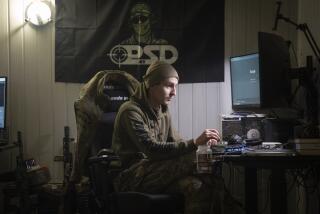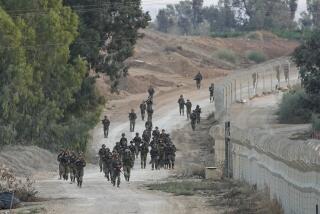Simple Mission Became 18-Hour Fight
- Share via
WASHINGTON — The soldiers of the Army’s 10th Mountain Division thought they were headed to the back door of the battle of Shahi Kot in eastern Afghanistan, on a mission to pick off fighters who might try to escape the main battle.
But within minutes of bounding out of their choppers at 6 a.m. Saturday, the infantrymen were bombarded with intense small-arms, mortar and rocket-propelled grenade fire from Al Qaeda and Taliban holdouts dug into the cliffs above.
For the next 18 hours, they were trapped by an enemy force--and faulty intelligence may have been partly to blame.
“Throughout the whole day, [it was] RPG rounds, machine guns, mortar rounds landing just everywhere,” Sgt. 1st Class Robert Healy said.
“I probably wouldn’t tell my mom the exact truth,” Healy said of the battle. “I wouldn’t want to worry her too much.”
Healy, 34, and Command Sgt. Maj. Frank Grippe, 39, both injured by shrapnel in the battle, spoke with reporters Thursday via a satellite phone link from Bagram air base north of the Afghan capital, Kabul, where the commanders of U.S. forces waging the battle are based.
The first mortar round wounded about six men, the second the same number, despite the torso-protecting body armor the infantrymen wore, said Healy, of Michigan.
Under intense pressure from the withering fire, the Americans quickly took what cover they could find on the barren valley floor and began shooting back at fighters on the snowcapped ridgelines high above.
Healy, Grippe and dozens of others from the Army’s elite mountain fighting unit had embarked with no expectation of such fierce resistance.
Their mission was to form “blocking positions” in the valley, a military term for blocking the enemy’s possible escape. Theirs was an opening move in Operation Anaconda, designed to encircle Al Qaeda and Taliban fighters in an area of 60 to 70 square miles--and then crush them.
Allied Afghan forces were supposed to have flushed Al Qaeda and Taliban fighters from strongholds toward the U.S. forces, but the Afghans also came under enemy fire and never made it to their position, the soldiers said.
Grippe, the senior enlisted man on the ground in the battle, said about 125 men were carried into the valley aboard CH-47 Chinook helicopters. He ordered “hunter-killer” sniper teams placed along the valley to the south, and men from the Army’s 101st Airborne Division took up positions in the northern part of the valley, Grippe said.
The pre-battle picture painted by intelligence briefers “was just a little bit different than the actual events happening on the ground,” said Grippe, of New York. His men landed, he said, “at the base of an Al Qaeda stronghold.”
Size of Enemy Force Was Underestimated
In Washington, a senior military officer with knowledge of the operation said flawed intelligence and analysis put the soldiers in the vulnerable spot.
“They were supposed to be the blocking force,” the officer said. “And all of a sudden, they found themselves at the bottom of a valley with fire raining down on them from these guys in entrenched positions on a mountainside. They basically had them pinned down for 18 hours.”
The intelligence failure was one of several that plagued commanders leading the ground assault in the mountains near Gardez, in eastern Afghanistan, the officer said.
“There was some faulty intelligence and analysis indicating that the opposing force was smaller than it was,” the official said. “We would hope to have had a better sense of the force size.”
The official added: “There was also a sense that if confronted with a ground force, that these guys would choose to bail, that if they had good escape routes staked out, they would break and run. . . . But it didn’t work out. So we had to regroup and rethink.”
Defense Secretary Donald H. Rumsfeld on Thursday defended the intelligence gathering that went into the operation, for which U.S. forces had been preparing for weeks.
“It is very difficult to know the number of Al Qaeda and Taliban that are there . . . the numbers have been changing dramatically--that is, the speculation as to how many are there,” Rumsfeld told Pentagon employees at a “town hall” meeting. “And I suspect we will not know how many are in there until it’s over.”
For the U.S. soldiers in the valley, the barrage from dark-clothed fighters hidden on snowy ridges and in mountainside caves was brutal.
Ten minutes into the battle, with the infantrymen dodging bullets and mortar fire, Al Qaeda fighters “came out of caves and well-fortified positions,” Grippe said. “We experienced a heavy volume of fire from the mountains above us. We returned fire, and we did kill Al Qaeda elements.”
“We all ducked behind kind of a small bowl area with cover and concealment on pretty much four sides,” Healy said. “Everybody got organized and we started returning fire.”
Soldiers Recall Acts of Bravery
Within about 30 minutes, U.S. fighter jets, bombers, AH-64 Apache helicopters and AC-130 gunships started plowing the skies overhead, Grippe said. “That quieted things down. We finally got some Apache aircraft to help us out.”
The infantrymen used 7.62-millimeter sniper rifles and machine guns to beat back their foe, Grippe said.
“I actually witnessed some of my guys taking out Al Qaeda targets out to ranges of 500 meters,” Grippe said. “So they really did a good job. They stayed cool under fire.”
“Basically I’ll tell you, we didn’t run from the fight. It wasn’t a Mogadishu,” he said, referring to the ill-fated 1993 incident in Somalia in which the U.S. military evacuated the country after taking heavy casualties. “We just kept the enemy fixed all day and kept the CAS [close air support] coming, and any time we could actually visibly see a target, we’d eliminate that Al Qaeda element.”
There were many instances of bravery, the solders said. During one of the mortar rounds, Healy, Grippe and about six or seven other men moved to a different position to avoid more fire.
“So we pushed away,” Healy said. “About five of the guys from Charlie Company, they stayed up on the ridgeline and they were receiving sniper fire and machine-gun fire, rounds were bouncing all around them, but they stayed there to cover our movement. None of them faltered. They knew they could get hit at any time, but they stayed there and held their ground and made sure we got out of there.”
Grippe said the firefight continued from 6 a.m. until 8 p.m., when his wounded men were taken out. After being trapped for four more hours, he and the remainder of his forces were airlifted out of the battle area at midnight.
Grippe had been hit by shrapnel in the back of his thigh.
“I guess I’ll be setting off airport metal detectors the rest of my life,” he said. Once his wounds heal, he said, he intends to head back into the mountains with his men.
“Our infantry fought very well that day,” he said.
Healy, hit by shrapnel in the leg, shoulder and behind the ear, said he and his fellow soldiers were fortunate to be facing a foe with more determination than marksmanship.
“We didn’t think it would be that high a volume of fire coming at us,” Healy said. “Luckily, they weren’t accurate shots.”
More to Read
Sign up for Essential California
The most important California stories and recommendations in your inbox every morning.
You may occasionally receive promotional content from the Los Angeles Times.













